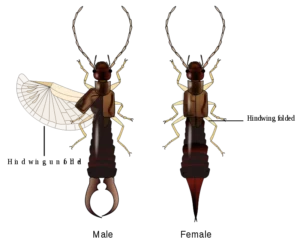A few tiny species with no wings belong to the hexapoda order, but as adults, most insects have wings. Let us explore some types of hexapoda below.
- Springtails
- Entomobryomorphs
- Polymorphs
- Globular springtails
- Mayflies
- dragonflies and damselflies
- Adult damselflies
- Grasshoppers
- Earwigs
- Termites
- True bugs
- Butterflies and moths
- Diptera
Springtails
Springtails belongs to the class of collembola. Springtails display a range of eating behaviours, including herbivory, carnivory, and detritivore. Collembolans, often known as springtails, are typically more than 5 mm in length. Three distinct springtail species differ from one another in terms of overall shape, external segmentation, leaping methods, eyes, habitat, and other features.

Entomobryomorphs
Entomobryomorphs is the first subgroup of collembolans. It lacks a pronotum and seems to have a neck. It has large legs, long antennae, well-developed eyes, and well-developed furcula.
Polymorphs
Polymorphs belongs to the class of collembola. The second subgroup of linear collembolans called polymorphs is squatter. Since the pronotum is present, they lack a neck. The spring, ventral tube, and eyes are little or non-existent, and the legs and antennae are short.
Globular springtails
Globular springtails belongs to the class of collembola. It make up the third category of collembolans. These have a short, rounded body shape due to the fusion of the thoracic and abdominal segments.
Mayflies
Mayflies belongs to the order Ephemeroptera, which relates to the adults’ brief lifespan, meaning “temporary wings”. Mayflies that are adults, do not eat and lack functional mouth and stomach. They multiply and spread out (usually not travelling far from water). The wings cannot be folded; they stand up when closed (as in a butterfly).

Dragonflies and Damselflies
Dragonflies and damselflies belong to the order odonates. Odonates are hemimetabolous, have aquatic nymphs and terrestrial adults, and do not fold their wings like mayflies. Both as nymphs and as adults, odonates are predators that mostly eat other invertebrates.
Adult damselflies
Adult damselflies are smaller and more delicate-looking than adult dragonflies. It maintain their wings horizontally at rest, whereas adult damselflies rest with their wings “down”. Damselflies wings are vertically arranged, however, because of the thoracic segments’ acute angles, this vertical posture is along the abdomen.
Grasshoppers
Grasshoppers belong to the order “Orthoptera”, which means “straight wings”. It is given this name because the wings are straight throughout, even though they may have longitudinal pleats. Other examples are crickets, locusts, and katydids. Big hind legs (designed for leaping), large pronotum, and thicker forewings are traits of orthopterans.
Earwigs
Earwigs belong to the order “Dermaptera”. The word “earwig” may have originated from hind wings, which resemble human ears. Two characteristics that define earwigs are their paired cerci (forceps), which frequently resemble pinchers, and their short, thickened forewings. Earwigs can be predators, herbivores, or detritivores.

Termites
Termites belong to the order Blattodea. Termites are eusocial, hemimetabolous insects. Termites typically consist of the queen (the only egg layer, who may be extremely enormous), workers, and soldiers, which are three physically distinct classes. Other examples are wood roaches, and cockroaches. Some termite mounds are at least 70 years old, proving that queens may live a lengthy life.
True bugs
True bugs belong to the order Hemiptera. The majority of hemipterans eat on plants, although some are predators and a few are parasites (e.g., bedbugs). It can be divided into two categories based on how the wings are supported when at rest. In one group, the wings are kept flat over the abdomen. In the other group, the wings are draped over the back in a “tent-like” fashion and have a uniform texture throughout.
Butterflies and moths
Butterflies and moths have large, occasionally brightly colored wings, coiled sucking mouthparts and scales on the wings and bodies. Moths keep their wings “tent-like” or flat outward while resting, but butterflies hold their wings up while at rest and have clubbed antennae. In general, moths are nocturnal whereas butterflies are diurnal.
Diptera
The group of flies is enormous and diversified. Diptera, which means “two wings”, got its name because only the first pair of its wings resemble wings. Adults have mouthparts for chewing or sucking and they can feed on fungi, herbs, prey, predators, parasitoids, blood, or liquids (e.g., nectar).
Other examples of hexapoda
Most of the hexapoda are terrestrial or freshwater aquatic, while only a few are found in marine habitats. Some other examples of hexapoda are listed below.
- Praying mantids
- Stoneflies
- Thrips
- Tree hoppers
- Beetles, grubs
- lacewings
- Owlflies
- Ant lions
- Ants, wasps, and bees
- Caddisflies
Conclusion
From the above article, it can be concluded that there are numerous species in the subphylum hexapoda, especially among the insects, that they may be referred to as the modal animals.
Also Read:
- Do animal cells have vacuoles
- Is mitochondrial dna inherited
- Water miscible
- Do bacteria have a nucleus
- Hexapoda characteristics
- Commensal examples
- Are proteins traits 2
- Moss examples
- Bacterial cell type
- Enzymes in cytoplasm

Hello, I am Bhairavi Rathod, I have completed my Master’s in Biotechnology and qualified ICAR NET 2021 in Agricultural Biotechnology. My area of specialization is Integrated Biotechnology. I have the experience to teach and write very complex things in a simple way for learners.